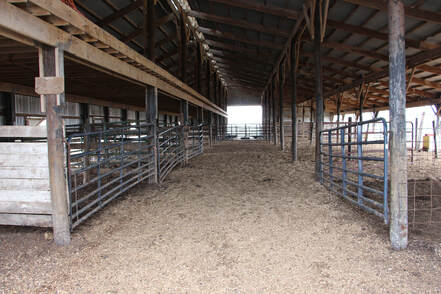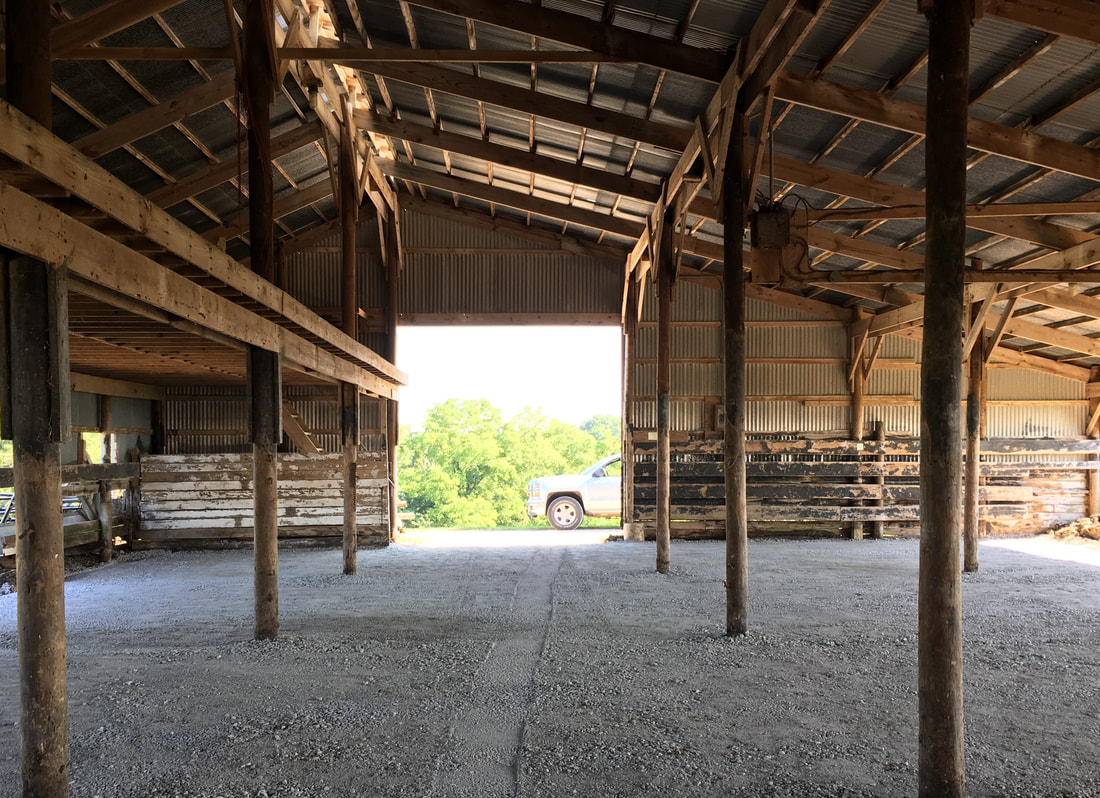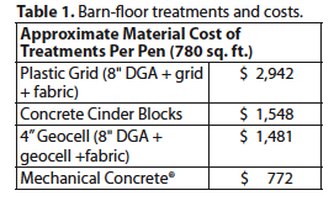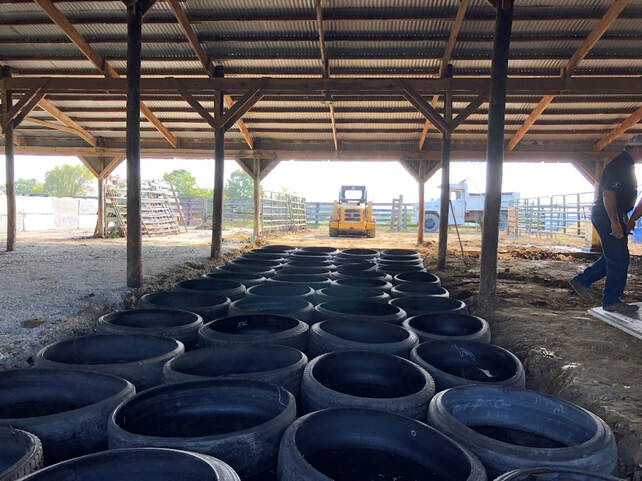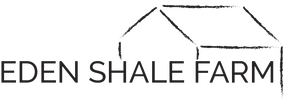Click the button below for an update on how each flooring is performing:
Barn-floor design is critical to the physical and thermal comfort, health, and safety of cattle. Generally speaking, barn flooring is the surface on which an animal stands, lies down, and excretes its urine and manure. Therefore, to meet animal needs, it must be durable, not slippery, and well-drained as well as comfortable, warm, and dry. In addition to providing animal comfort, the flooring should easily be cleaned. No single material, from concrete to soil, meets all of these specifications. With these considerations in mind, a demonstration project at Eden Shale Farm examined how four different materials could be used to provide comfort and make manure management and removal more effective, since one goal was to prevent a loader bucket from removing the rock flooring due to gouging into the flooring.
We began renovating our bull barn flooring in Fall 2019. The flooring has been completed using 4 different products (one product per pen). This will allow us to compare the different designs under the same conditions. A manure stackpad was also created on the end of the barn using concrete bin blocks. This will allow us to store the manure under roof and contain it until we are able to spread it the following spring/summer when conditions and time allow. We will continue to monitor each floor type and provide updates. Below are before and after pictures of the bull barn floor renovation.
Four barn-floor designs were used—a four-inch geocell, plastic grid, Mechanical Concrete®, and concrete cinder blocks.. All of the treatments used filter fabric and rock (rock was used to provide infiltration, and filter fabric to provide reinforcement, friction, separation, and drainage.). Table 1 lists flooring treatments and material costs for each application.
Rock and Fabric Filter
The use of rock and filter fabric can reduce the cost of a flooring project. However, with aggressive and repeated scraping, rock can be removed, which means it eventually will need to be replaced. After repeated reapplication of rock, these types of surfaces can be just as expensive as concrete over time. When there is a layer of manure and bedding, it is difficult to get a reapplication of rock to adhere to the old surface. Filter fabric and rock pads will eventually fail. The estimated lifespan of a heavy traffic pad is about 10 years with proper maintenance. With this in mind, a goal of this demonstration project was to show how different materials could be used with filter fabric and rock pad to extend the life of the flooring.
The use of rock and filter fabric can reduce the cost of a flooring project. However, with aggressive and repeated scraping, rock can be removed, which means it eventually will need to be replaced. After repeated reapplication of rock, these types of surfaces can be just as expensive as concrete over time. When there is a layer of manure and bedding, it is difficult to get a reapplication of rock to adhere to the old surface. Filter fabric and rock pads will eventually fail. The estimated lifespan of a heavy traffic pad is about 10 years with proper maintenance. With this in mind, a goal of this demonstration project was to show how different materials could be used with filter fabric and rock pad to extend the life of the flooring.
Floor Type #1 - Geocell Material
A geocell product was available in four-inch and six-inch depths. The four-inch geocell material was used by laying down geotextile fabric. The geocell was stretched out and staked, using two-foot stakes. Adjacent geocell sections were tied together using zip ties. Dense grade aggregate (DGA) was backfilled into the voids (Figure 1).
The geocell product walls seemed to be too flimsy for placing the rock. However, observations of the rock being placed showed that the geocell did hold up. How well it lasts will be determined later.
The geocell product walls seemed to be too flimsy for placing the rock. However, observations of the rock being placed showed that the geocell did hold up. How well it lasts will be determined later.
Floor Type #2 - Plastic Grid with Filter Fabric Backing
A 4 ft by 150 ft roll of plastic grid with a geotextile backing was used to create this treatment. A base layer of filter fabric, topped with six inches of dense grade aggregate (DGA) was placed and leveled within two inches of the final grade. Four strips of a two-inch layer of interlocking plastic grid, with a filter fabric backing, was placed on the rock, connected, and then backfilled with DGA.
The ease of installing the plastic roll made it a nice choice. However, the gravel had to be completely level before adding the plastic grid with the geofabric backing. Otherwise, voids could produce deflection or an unwanted hollow feel when walking on it. Experience with other plastic grid materials indicate that, for this application, it would be easier and possibly better if we had used the roll without the fabric backing. This would allow the installer to lift the grid where needed, with the rock installed, which allows the rock to fall out, and create a level surface.
The ease of installing the plastic roll made it a nice choice. However, the gravel had to be completely level before adding the plastic grid with the geofabric backing. Otherwise, voids could produce deflection or an unwanted hollow feel when walking on it. Experience with other plastic grid materials indicate that, for this application, it would be easier and possibly better if we had used the roll without the fabric backing. This would allow the installer to lift the grid where needed, with the rock installed, which allows the rock to fall out, and create a level surface.
Floor Type #3 - Mechanical Concrete
Mechanical Concrete® is a process in which the sidewalls of used truck tires are removed, leaving a tread cylinder. The tread cylinder was placed on top of a layer of geotextile fabric (see image). Dense grade aggregate (DGA) was then placed inside and around the tire voids. The goal was to have the top edge of the tire cylinder be at grade level. We bought the pre-cut truck tires out of Carter County, KY. The reason we went with truck tires instead of car tires is because the truck tires were thicker and cost the same as the car tires.
The tires were arranged using a straight row pattern as opposed to an offset pattern. This layout resulted in a larger void between the tires compared to the offset pattern. It also required fewer tires. With this option, it appears that it would take a long time before a loader bucket could penetrate the thick edge pattern created by the tread cylinders. The cost difference between a traditional DGA and fabric application versus the Mechanical Concrete® was $772 compared to a traditional filter fabric and rock pad, which would have cost $716. The contribution that the tires provided to the treatment gives the impression that the lifespan of the floor was increased significantly compared to a traditional filter fabric and rock implementation, which is expected to last 10 years with proper maintenance. The addition of the tires cost $56 which seems like a small price to pay for extending the life of the floor by several fold.
The tires were arranged using a straight row pattern as opposed to an offset pattern. This layout resulted in a larger void between the tires compared to the offset pattern. It also required fewer tires. With this option, it appears that it would take a long time before a loader bucket could penetrate the thick edge pattern created by the tread cylinders. The cost difference between a traditional DGA and fabric application versus the Mechanical Concrete® was $772 compared to a traditional filter fabric and rock pad, which would have cost $716. The contribution that the tires provided to the treatment gives the impression that the lifespan of the floor was increased significantly compared to a traditional filter fabric and rock implementation, which is expected to last 10 years with proper maintenance. The addition of the tires cost $56 which seems like a small price to pay for extending the life of the floor by several fold.
Floor Type #4 - Cinder Blocks
Floor Type #4 - Cinder Blocks
The cinder-block treatment was created by laying down filter fabric, placing the blocks (open end up), and then backfilling with dense grade aggregate (DGA). This treatment should provide a 49 percent pervious surface. The surface of the blocks acts as the final edge or surface to facilitate manure removal with a bucket loader but without removing rock.
The cinder-block flooring treatment was the most labor intensive treatment with each block weighing approximately 30 lbs. After a few days, the surface of the DGA showed a noticeable amount of dampness (see image below). In addition to providing infiltration, cinder blocks absorb moisture from the environment. The blocks are analogous to a sponge as they wick moisture from the atmosphere or environment. A bench top lab study suggested that each block could store one-gallon of liquid. The observation of moisture does suggest that a disadvantage of this flooring might be that it draws moisture to the surface, near a lying animal and bedding. Additional observations and measurements would need to be collected to determine the outcome of this effect.
The cinder-block treatment was created by laying down filter fabric, placing the blocks (open end up), and then backfilling with dense grade aggregate (DGA). This treatment should provide a 49 percent pervious surface. The surface of the blocks acts as the final edge or surface to facilitate manure removal with a bucket loader but without removing rock.
The cinder-block flooring treatment was the most labor intensive treatment with each block weighing approximately 30 lbs. After a few days, the surface of the DGA showed a noticeable amount of dampness (see image below). In addition to providing infiltration, cinder blocks absorb moisture from the environment. The blocks are analogous to a sponge as they wick moisture from the atmosphere or environment. A bench top lab study suggested that each block could store one-gallon of liquid. The observation of moisture does suggest that a disadvantage of this flooring might be that it draws moisture to the surface, near a lying animal and bedding. Additional observations and measurements would need to be collected to determine the outcome of this effect.
Summary
This case study demonstrated four floor designs for housing cattle that meet the animals’ needs while facilitating manure removal, storage and handling. All of the treatments—four-inch geocell, plastic grid, Mechanical Concrete®, and concrete cinder blocks—would last longer than a fabric and rock pad. However, the concrete block flooring showed significant dampness and, because of the weight of the blocks, was hard to manage and labor intensive. Both the geocell and plastic grid were more expensive initially than other options but drained well, which would reduce bedding costs over time. Mechanical Concrete® was the easiest to install and was very cost-effective considering the additional years it could add to a fabric and rock underlayment.
Frequently Asked Questions
Where did you purchase the materials for the bull barn flooring?
We get all our construction materials from Site Supply, Inc. The drainage "pipe" we used is the J-DRain MVP-6. Click here to see details.
Where did you purchase the tires for the flooring?
We buy the tires pre-cut from Porter Tire in Olive Hill, KY. They are about $1.50 a piece.
Is it possible to scrape out the manure without dislodging the honeycomb grids?
We have had some of the Geo Grid “honeycomb” flooring in place for 4 years and it is still functioning the same as when we installed it. I have scraped it with the skid steer numerous times, even spinning on it to see if it would hold up, and it always has. In my opinion it is a durable product that is comparable to concrete in terms longevity.
Which flooring type is best, in your opinion?
In my experience the Geo Grid is an excellent option inside of buildings, or any structure that is under roof. It will allow the moisture to percolate down away from the surface and will keep the flooring drier. However, the total cost of installation for the geo grid is approximately the same as concrete on a square foot basis. For this reason the geo grid is best served when used under a roof. If you are creating a feeding area outside that is open with no roof, it is best to pour concrete.
We have also used some other cheaper designs of flooring grid, but I like the honeycomb geo grid the best. The other designs are a hassle to install.
We have used some tire cylinders (Mechanical Concrete) that has worked good so far and is a much cheaper option. They are simply truck tires that have both sidewalls cut out. We put down geotextile fabric and then lay the tread cylinders down side by side and back fill the tires with dense grade gravel. I have only had these installed for a year, but they are holding up well so far. I think over time they will need some of the gravel replaced, but again, it is a much cheaper option to install. You can read more about this option here
We have also used some other cheaper designs of flooring grid, but I like the honeycomb geo grid the best. The other designs are a hassle to install.
We have used some tire cylinders (Mechanical Concrete) that has worked good so far and is a much cheaper option. They are simply truck tires that have both sidewalls cut out. We put down geotextile fabric and then lay the tread cylinders down side by side and back fill the tires with dense grade gravel. I have only had these installed for a year, but they are holding up well so far. I think over time they will need some of the gravel replaced, but again, it is a much cheaper option to install. You can read more about this option here
Copyright © Kentucky Beef Network, LLC. All rights reserved. This content may not be copied, reproduced, distributed, or used in any manner without written approval from Kentucky Beef Network, LLC. For Informational Purposes Only.
CONTACT US |
EMAIL SIGN UP |
|
Eden Shale Farm
245 Eden Shale Rd. Office: (859) 278-0899 Owenton, KY 40359 Fax: (859) 260-2060 © 2021 Kentucky Beef Network, LLC.. All rights reserved.
|
Receive our blog updates
|

